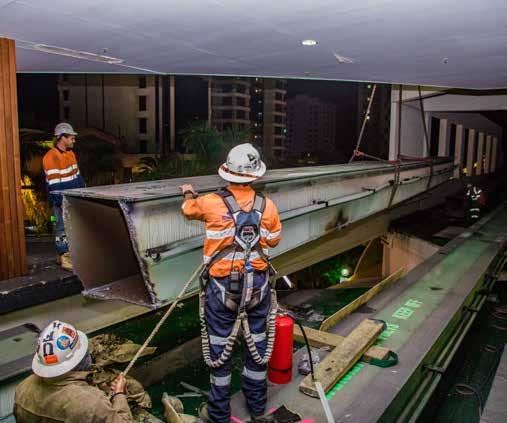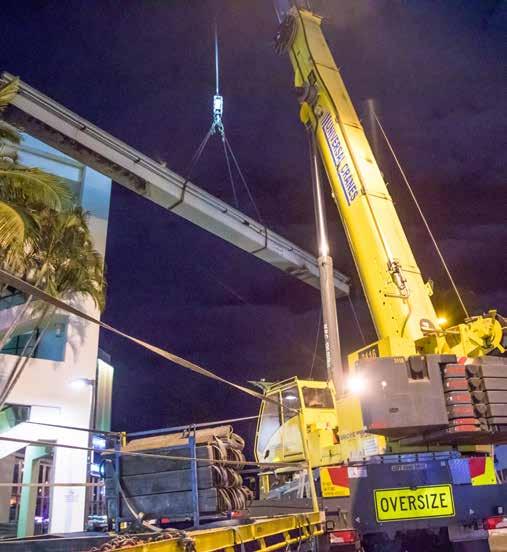
3 minute read
INCIDENT REPORT
May 2017 Gold Coast, Australia
Universal Cranes was contracted to provide crane hire and personnel for the removal of beam sections on a demolition project. While lifting one of the beam sections, a Near Miss occurred when the crane was overloaded and subsequently lunged forward. A lift study was completed prior to the job commencing, but last-minute changes in the demolition methodology made the beams significantly heavier than planned. Fortunately, there were no injuries or damage incurred in the incident; however, as a serious Near Miss, there was potential for catastrophe and important lessons to be learned from the incident.
Advertisement
Incident Snapshot
• Near miss when crane lunged forward due to overloading • No injuries or damage but high potential • Breakdown in communication, time pressures and repetition of lift were contributing factors • Crane not sufficiently derated for engineered demolition
The lift
Universal Cranes mobilised two 130T Grove GMK5130 cranes for the engineered deconstruction of the beams. Lift studies and other relevant documentation were prepared based on the methodology and load weights provided. However, during the deconstruction, a decision was made to cut the beams closer to the headstock to eliminate sparks and slag that were falling into the corridor below. The engineer confirmed the change in the

cutting point would not affect the structural integrity of the headstocks. However, the resulting change to the beam weight and dimensions was not considered.
The estimated beam weight was 410kg/m. However, the actual beam weight was 482kg/m.
The length increased from 29m to approximately 35m resulting in the total weight increasing from 11.9t to 16.9t. This information was not clearly communicated to all parties meaning a new lift plan was not prepared based on the new beam weight. When the beam was cut free, the crane was outside its safe working limit and consequently lunged forward. Fortunately, this incident was a Near Miss, but there was a high possibility of the beam or the crane falling and impacting people, structures or other vehicles. This could have caused significant injuries to workers and damage to the surrounding area.
Contributing factors and lessons learned
There were multiple factors that led to this incident and important lessons learned:
Contributing factor Lesson learned
Breakdown in communication between stakeholders, resulting in failure to convey changes and their impact on the lift plan before the lift commenced
Time pressure to execute the lift within the highway closure times
Complacency because almost identical lifts had been performed by the team in the past with no issues. (These were based on the load weights prior to the changes in cutting points.) Ensure any changes in the load, site, environment or methodology are clearly communicated and the Lift Plan updated accordingly before the lift commences. The Lift Plan must be reviewed and signed off prior to the lift commencing.
Accidents happen when teams skip essential steps to complete a job ahead of schedule. A strong safety culture that supports safety as a non-negotiable priority empowers teams to always put safety ahead of schedule pressures.
Familiarity with a lift type does not mean that shortcuts can be taken in the required process. A normal operating mindset of ‘no two lifts are ever the same’ should be in place.
Insufficient derating of the crane suitable for demolition/ engineered deconstruction lifts. The suggested derating for demolition is 50% or 33% as per CICA’s Position Paper recommendations for engineered lifts, and these guidelines should always be followed. Had the crane been correctly derated for demolition, this would have further mitigated any issues caused by the inaccurate data provided.

To prevent an incident of this nature reoccurring, Universal Cranes educated staff on the importance of derating cranes for demolition jobs and reinforced the importance of conforming to industry standards in respect to demolition to account for any miscalculation or unanticipated load weights in engineering deconstruction scenarios. Any changes to the job, lift plans or studies must now be reviewed and signed off and clearly communicated to everyone on site.









